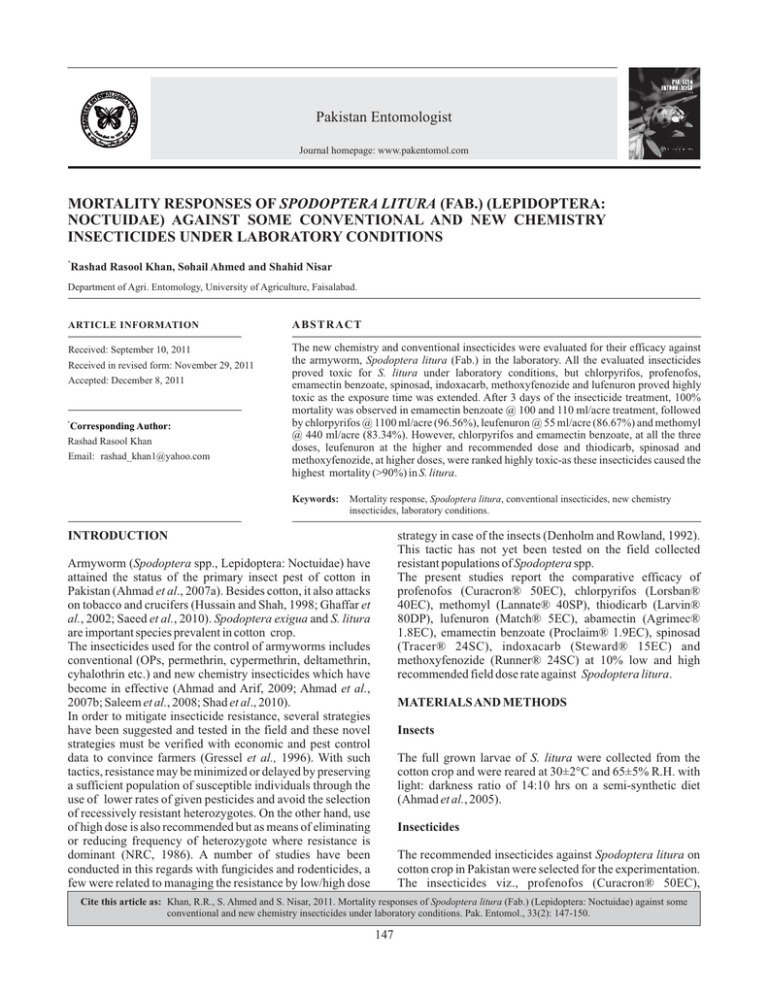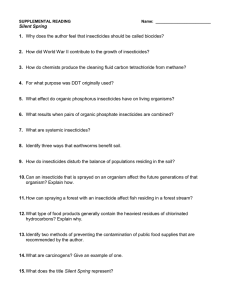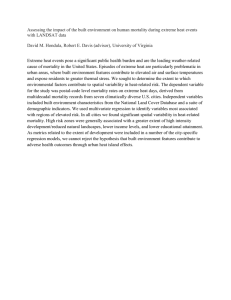Entomol. Journal Page Setting, all articles
advertisement

Pakistan Entomologist Journal homepage: www.pakentomol.com MORTALITY RESPONSES OF SPODOPTERA LITURA (FAB.) (LEPIDOPTERA: NOCTUIDAE) AGAINST SOME CONVENTIONAL AND NEW CHEMISTRY INSECTICIDES UNDER LABORATORY CONDITIONS * Rashad Rasool Khan, Sohail Ahmed and Shahid Nisar Department of Agri. Entomology, University of Agriculture, Faisalabad. ARTICLE INFORMATION A BS TR A C T Received: September 10, 2011 The new chemistry and conventional insecticides were evaluated for their efficacy against the armyworm, Spodoptera litura (Fab.) in the laboratory. All the evaluated insecticides proved toxic for S. litura under laboratory conditions, but chlorpyrifos, profenofos, emamectin benzoate, spinosad, indoxacarb, methoxyfenozide and lufenuron proved highly toxic as the exposure time was extended. After 3 days of the insecticide treatment, 100% mortality was observed in emamectin benzoate @ 100 and 110 ml/acre treatment, followed by chlorpyrifos @ 1100 ml/acre (96.56%), leufenuron @ 55 ml/acre (86.67%) and methomyl @ 440 ml/acre (83.34%). However, chlorpyrifos and emamectin benzoate, at all the three doses, leufenuron at the higher and recommended dose and thiodicarb, spinosad and methoxyfenozide, at higher doses, were ranked highly toxic-as these insecticides caused the highest mortality (>90%) in S. litura. Received in revised form: November 29, 2011 Accepted: December 8, 2011 * Corresponding Author: Rashad Rasool Khan Email: rashad_khan1@yahoo.com Keywords: Mortality response, Spodoptera litura, conventional insecticides, new chemistry insecticides, laboratory conditions. strategy in case of the insects (Denholm and Rowland, 1992). This tactic has not yet been tested on the field collected resistant populations of Spodoptera spp. The present studies report the comparative efficacy of profenofos (Curacron® 50EC), chlorpyrifos (Lorsban® 40EC), methomyl (Lannate® 40SP), thiodicarb (Larvin® 80DP), lufenuron (Match® 5EC), abamectin (Agrimec® 1.8EC), emamectin benzoate (Proclaim® 1.9EC), spinosad (Tracer® 24SC), indoxacarb (Steward® 15EC) and methoxyfenozide (Runner® 24SC) at 10% low and high recommended field dose rate against Spodoptera litura. INTRODUCTION Armyworm (Spodoptera spp., Lepidoptera: Noctuidae) have attained the status of the primary insect pest of cotton in Pakistan (Ahmad et al., 2007a). Besides cotton, it also attacks on tobacco and crucifers (Hussain and Shah, 1998; Ghaffar et al., 2002; Saeed et al., 2010). Spodoptera exigua and S. litura are important species prevalent in cotton crop. The insecticides used for the control of armyworms includes conventional (OPs, permethrin, cypermethrin, deltamethrin, cyhalothrin etc.) and new chemistry insecticides which have become in effective (Ahmad and Arif, 2009; Ahmad et al., 2007b; Saleem et al., 2008; Shad et al., 2010). In order to mitigate insecticide resistance, several strategies have been suggested and tested in the field and these novel strategies must be verified with economic and pest control data to convince farmers (Gressel et al., 1996). With such tactics, resistance may be minimized or delayed by preserving a sufficient population of susceptible individuals through the use of lower rates of given pesticides and avoid the selection of recessively resistant heterozygotes. On the other hand, use of high dose is also recommended but as means of eliminating or reducing frequency of heterozygote where resistance is dominant (NRC, 1986). A number of studies have been conducted in this regards with fungicides and rodenticides, a few were related to managing the resistance by low/high dose MATERIALS AND METHODS Insects The full grown larvae of S. litura were collected from the cotton crop and were reared at 30±2°C and 65±5% R.H. with light: darkness ratio of 14:10 hrs on a semi-synthetic diet (Ahmad et al., 2005). Insecticides The recommended insecticides against Spodoptera litura on cotton crop in Pakistan were selected for the experimentation. The insecticides viz., profenofos (Curacron® 50EC), Cite this article as: Khan, R.R., S. Ahmed and S. Nisar, 2011. Mortality responses of Spodoptera litura (Fab.) (Lepidoptera: Noctuidae) against some conventional and new chemistry insecticides under laboratory conditions. Pak. Entomol., 33(2): 147-150. 147 Khan et al. / Pakistan Entomologist 2011, 33(2): 147-150 level of resistance was found in Spodoptera exigua against chlorpyrifos. All the larvae treated with the recommended and higher dose rates of methomyl were found dead after 7 days of its application whereas 83.34 % mortality was observed after 7 days when the larvae were treated with its lower dose rate (360 g/acre). The higher dose rate (440 g/acre) of thiodicarb caused 93.34 % mortality at the 7th day of treatment application and the recommended and lower dose rates (400 and 360 g/acre) caused 80 and 73.32 % mortality, respectively. Among the new chemistry insecticides, lowest mortality (53.31%) was found in abamectin (180 ml/acre) even after 7 days of its application; however, the mortality increased with an increase in the dose rate. The higher dose rates of spinosad (44 ml/acre) caused 93.33% mortality after 7 days, but its recommended dose (40 ml/acre) caused 86.66% mortality of the S. litura larvae. After 7 days of application, the larval mortality reached up to 83.34% in the larvae treated with higher dose rate of indoxacarb (110 ml/acre). Almost the same mortality (83.33%) was observed after 7 days of treatment with methoxyfenozide (100 ml/acre) and when the dose was increased to 110 ml/acre, the mortality was 93.23% after 7 days of application. Insecticides like, chlorpyrifos, emamectin benzoate at all three dose rates, lufenuron-at higher and recommended dose rates and thiodicarb, spinosad and methoxyfenozide-at higher dose rates, were ranked highly toxic, as maximum mortality levels were observed in chlorpyrifos @ 900, 1000 and 1100 ml/acre, methomyl @ 400 and 440 g/acre, lufenuron @ 50 and 55 ml/acre and emamectin benzoate @ 90, 100 and 110 ml/acre, which were followed by thiodicarb @ 440 g/acre, lufenuron @ 45 ml/acre, spinosad @ 44 ml/acre and methoxyfenozide @ 110 ml/acre, after 7 days of the treatments. Same results were reported by Sparks et al. (1996) for spinosad and emamectin benzoate as well as by Mascarenhas et al. (1996) for chlorpyrifos and spinosad. The results of present study are also confirmatory to those of Adamczyk et al., (1999) who reported that the novel insecticides like chlorfenapyr, methoxyfenozide, spinosad and tebufenozide were more effective to the pest. The results regarding the indoxacarb in our experiment, were also comparable to those of Hammes et al. (1998) who reported it very effective against S. litura and safe to many beneficial insects. The results can also be compared with those of Ahmad and Saleem (2004) who reported that amongst new chemistry insecticides, emamectin benzoate and lufenuron resulted in maximum mortality of S. litura. Ahmad et al., (2005) also reported that emamectin benzoate proved to be the best insecticide followed by lufenuron, spinosad and indoxacarb, respectively in their time-oriented mortality at three concentration levels against S. litura; however, abamectin proved to be the least effective to control this pest. These results also support our findings. The overall results of this study suggest emamectin benzoate as the best insecticide along with other new chemistry insecticides a long- lasting control tactic for the farming community against S. litua. Lufenuron, indoxacarb, methoxy fenozide and spinosad also chlorpyrifos (Lorsban® 40EC), methomyl (Lannate® 40SP), thiodicarb (Larvin® 80DP), lufenuron (Match® 5EC), abamectin (Agrimec® 1.8EC), emamectin benzoate (Proclaim® 1.9EC), spinosad (Tracer® 24SC), indoxacarb (Steward® 15EC) and methoxyfenozide (Runner® 24SC) were obtained in the form of their commercial formulations from the respective manufacturers. Three doses for each insecticide i.e., the recommended dose against S. litura and 10% below and above the recommended dose rate, were prepared in an Analar grade Acetone. A control treatment of acetone/distilled water applications was also included, for each test, to assess the natural mortality rates of the test insect species. Bioassay Ten larvae of S. litura (3rd instar), of uniform age, were exposed to three different concentrations of insecticides, using a leaf-dip technique, as recommended by the Insecticides Resistance Action Committee (IRAC) of GIFAP (Anonymous, 1990). Unsprayed cotton leaves, were collected from the field, washed and dipped into the insecticide (Treatment) solutions, for ten seconds, with a gentle agitation and dried on the tissue papers. The dried leaves were then placed in the petri dishes having a moist filter paper, in order to avoid any desiccation. The treatments were observed, after 3 and 7 days for their effects. The effects of test insecticides were judged on the basis of insect mortality levels, after certain time periods. The data were analyzed statistically at 5% level of probability using Duncan's Multiple Range Test and the insecticides were categorized on the basis of percentage mortality, as; Harmless (<50% mortality); Slightly harmful (50-79% mortality); Moderately harmful (80-89% mortality) and Harmful (>90% mortality) (Khan, 2010, unpublished data). RESULTS AND DISCUSSION The data regarding the percentage-mortality of the larvae of Spodoptera litura after 3 and 7 days of the insecticide treatments were found significantly different (Table 1). It is obvious from the data that 100% mortality was observed after 3 days of treatment application with emamectin benzoate at the dose rate of 100 and 110 ml/acre. While complete mortality of the larvae was observed after 7 days of treatment application when larvae were treated at the dose rate of 90 ml/acre of emmamectin benzoate. The mortality was also found to be 100% after 7 days of application at all the dose rates of lufenuron. The higher dose rate of chlorpyrifos (1100 ml/acre) also proved highly toxic as 96.56 % mortality was observed in the treated larvae after 3 days. The mortality of the larvae reached 100% after 7 days in all the treatments of chlorpyrifos. However, the lower dose rate of profenofos (450 ml/acre) proved slightly toxic as the treatments caused 66.67 % mortality even after 7 days of its application. The results documented by Ahmad and Arif (2009) are in partial agreement with our findings. They reported very low or no resistance in Earias vittella to emamectin benzoate and profenofos. Ahmad and Arif (2010) reported that very low Cite this article as: Khan, R.R., S. Ahmed and S. Nisar, 2011. Mortality responses of Spodoptera litura (Fab.) (Lepidoptera: Noctuidae) against some conventional and new chemistry insecticides under laboratory conditions. Pak. Entomol., 33(2): 147-150. 148 Khan et al. / Pakistan Entomologist 2011, 33(2): 147-150 proved to be the effective insecticides after emamectin, respectively. Table. 1 Percentage mortality (means±SE) of Spodoptera litura after 3 and 7 days of the insecticide applications. Treatments Insecticides Dose Mortality (%) Mortality (%) (means±SE) (means±SE) (g or ml /acre) 3 DAA 7 DAA T1 Profenofos (Curacron 50EC) 450 36.67±3.33l 66.67±3.33efg T2 Profenofos (Curacron 50EC) 500 46.68±3.34jkl 76.67±3.35cdef T3 Profenofos (Curacron 50EC) 550 53.34±3.32hijkl 86.66±3.31abc T4 Chlorpyrifos (Lorsban 40EC) 900 73.33±3.35cdefg 100.00±0.00a T5 Chlorpyrifos (Lorsban 40EC) 100 0 83.23±2.34ab 100.00±0.00a T6 Chlorpyrifos (Lorsban 40EC) 1100 96.56±2.33ab 100.00±0.00a T7 Methomyl (Lennate 40SP) 360 63.32±4.13efghij 83.34±3.33bcd T8 Methomyl (Lennate 40SP) 400 76.67±3.32cdefg 100.00±0.00a T9 Methomyl (Lennate 40SP) 440 83.34±3.33abcd 100.00±0.00a T10 Thiodicarb (Larvin 80DP) 360 66.67±6.27defghi 73.32±3.34cdef T11 Thiodicarb (Larvin 80DP) 400 73.31±3.33cdefg 80.00±0.00bcde T12 Thiodicarb (Larvin 80DP) 440 80.21±1.20bcde 93.34±3.35ab T13 Lufenuron (Match 5EC) 45 66.67±3.33defghi 93.33±3.23ab T14 Lufenuron (Match 5EC) 50 76.62±3.31cdef 100.00±0.00a T15 Lufenuron (Match 5EC) 55 86.67±3.35abc 100.00±0.00a T16 Abamectin (Agrimec 1.8EC) 180 36.65±3.23l 53.31±3.35g T17 Abamectin (Agrimec 1.8EC) 200 43.33±2.36kl 63.34±3.36fg T18 Abamectin (Agrimec 1.8EC) 220 50.00±1.20ijkl 73.41±4.12cdef T19 Emamectin benzoate (Proclaim 1.9EC) 90 83.31±3.34abcd 100.00±0.00a T20 Emamectin benzoate (Proclaim 1.9EC) 100 100.00±0.00a 100.00±0.00a T21 Emamectin benzoate (Proclaim 1.9EC) 110 100.00±0.00a 100.00±0.00a T22 Spinosad (Tracer 24SC) 36 66.67±3.33defghi 76.67±3.33cdef T23 Spinosad (Tracer 24SC) 40 70.00±0.00cdefgh 86.66±3.32abc T24 Spinosad (Tracer 24SC) 44 76.57±2.89cdef 93.33±3.33ab T25 Indoxacarb (Steward 15SC) 90 53.36±3.31hijkl 70.00±0.00def T26 Indoxacarb (Steward 15SC) 100 60.00±1.02fghijk 76.68±3.36cdef T27 Indoxacarb (Steward 15SC) 110 66.67±3.29defghi 83.34±3.34bcd T28 Methoxyfenozide (Runner 24SC) 90 56.67±3.31cdefgh 76.59±4.33cdef T29 Methoxyfenozide (Runner 24SC) 100 70.00±0.00cdefgh 83.33±3.33bcd T30 Methoxyfenozide (Runner 24SC) 110 76.67±2.91cdef 93.23±3.29ab T31 Control 0.00±0.00m Column wise means sharing similar letters do not differ significantly, at 0.05 probability level. 0.000±0.000h Spodoptera litura (Fab.) (Lepidoptera: Noctuidae) under laboratory conditions. Pak. Entomol., 26(2): 1-4. Ahmad, M., M.A. Saleem and M. Ahmad, 2005. Time - oriented mortality in leafworm, Spodoptera litura (Fab.) (Lepidoptera: Noctuidae) by some new chemistry insecticides. Pak. Entomol., 27(1):67-70. Ahmad, M., A.H. Sayyed, N. Crickmore, and M.A. Saleem, 2007b. REFERENCES Adamczyk, J.J., J.R. Leonard and J.B.G. Raves, 1999. Toxicity of selected insecticides to fall armyworms (Lepidoptera: Noctuidae) in laboratory bioassay studies. Florida Ento., 82(2): 230-236. Ahmad, M. and M.A. Saleem, 2004. Comparative efficacy of ten conventional and new chemistry insecticides against armyworm, Cite this article as: Khan, R.R., S. Ahmed and S. Nisar, 2011. Mortality responses of Spodoptera litura (Fab.) (Lepidoptera: Noctuidae) against some conventional and new chemistry insecticides under laboratory conditions. Pak. Entomol., 33(2): 147-150. 149 Khan et al. / Pakistan Entomologist 2011, 33(2): 147-150 Genetics and mechanism of resistance to deltamethrin in a field population of Spodoptera litura (Lepidoptera: Noctuidae). Pest Manag. Sci., 63: 1002–1010. Ahmad, M., M.I. Arif and M. Ahmad, 2007a. Occurrence of insecticide resistance in field populations of Spodoptera litura (Lepidoperta: Noctuidae) in Pakistan. Crop Prot., 26: 809-817. Ahmad, M., and M.I. Arif. 2009. Resistance of Pakistani field populations of spotted bollworm Erias vitella (Lepidoptera: Noctuidae) to pyrethroids, organophosphorous and new chemistry insecticides. Pest Manag. Sci., 65: 433-439. Ahmad, M., and M.I. Arif. 2010. Resistance of beet armyworm Spodoptera exigua (Lepidoptera: Noctuidae) to endosulfan, organophosphorous and pyrethroid insecticides in Pakistan. Crop Prot., 29: 1428-1433. Anonymous, 1990. Proposed insecticides/acaricide susceptibility tests. IRAC method No. 7. Bull., Eur. Plant Prot. Org., 20: 399400. Denholm I. and M.W. Rowland, 1992. Tactics for managing pesticide resistance in arthropods: Theory and practice. Annu. Rev. Entomol., 37:91-112 Ghaffar, A., M.B. Attique, M.R. Naveed and M.T. Jan, 2002. Host range and population dynamics of beet armyworm, Spodoptera exigua, in cotton agroecosystem of Punjab [Pakistan]. Pak. J. Zool., 34: 209-213. Gressel, J., S.N. Gardner and M. Mangel, 1996. Prevention versus remediation in resistance management. In: Molecular Genetics And Evolution Of Pesticide Resistance, Chapter 18, pp 169-186. ACS ACS Symposium Series, Vol. 645. American Chemical Society, Washington DC, USA. Hammes, G.G., D. Sherrod, D. Marsden, P. Dugger and D. Richter, 1998. Steward a novel new insecticide for cotton insect control. Proc. beltwide cott. conf., San Diego, California. V. 2: pp 12751276. Hussain, Z. and A.Q. Shah, 1998. Insect pests control of tobacco seedbed. Pak. Tobacco, 22: 17-22 Mascarenhas, V.J., B.R. Leonard, E. Burris and J.B. Graves, 1996. Beet armyworm control on cotton in Lousiana. Lousiana State University, Agricutural Center, Department of Entomology., 79(3): 336-343. National Research Council, 1986. Pesticide resistance: Strategies and tactics for management committee on strategies for the management of pesticide resistant pest populations. U.S. Nuclear Regulatory Commission Washington, DC, USA. Pp. 316-317. Saeed, S., A.H. Sayyed and I. Ahmad, 2010. Effect of host plants on life-history traits of Spodoptera exigua (Lepidoptera: Noctuidae) J. Pest Sci., 83 (2): 165-172. Saleem, M.A., M. Ahmad, M. Ahmad, M. Aslam, and A.H. Sayyed, 2008. Resistance to selected organochlorine, organophosphate, carbamate and pyrethroid in Spodoptera litura (Lepidoptera: Noctuidae) from Pakistan. J. Econ. Entomol., 101: 1667-1675. Shad, A.S., A.H. Sayyed, and M.A. Saleem, 2010. Cross-resistance, mode of inheritance and stability of resistance to emamectin in Spodoptera litura (Lepidoptera: Noctuidae). Pest Manag. Sci., 64: 839-846. Sparks, A.N., J.W. Norman and D.A. Wolfenbarger, 1996. Efficacy of selected insecticides against the beet armyworm, Spodoptera exigua, field and laboratory evaluations. Proc. beltwide cott. conf., Nashville, TN, USA, 2: 844-846. Cite this article as: Khan, R.R., S. Ahmed and S. Nisar, 2011. Mortality responses of Spodoptera litura (Fab.) (Lepidoptera: Noctuidae) against some conventional and new chemistry insecticides under laboratory conditions. Pak. Entomol., 33(2): 147-150. 150

